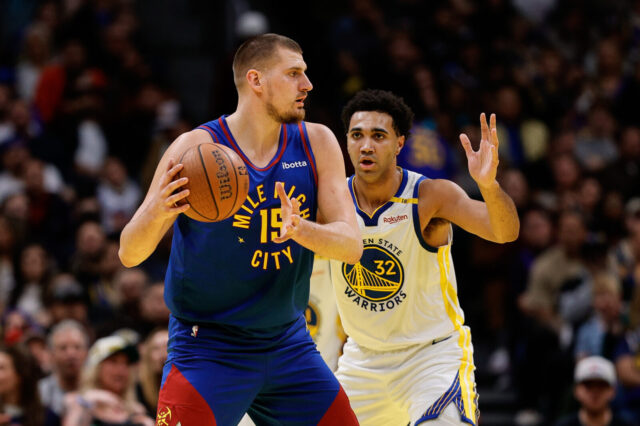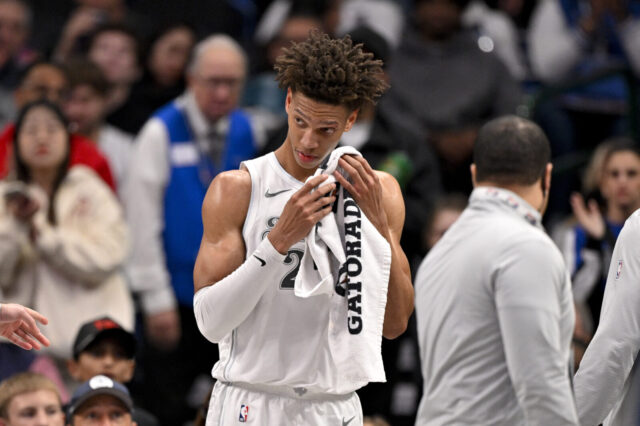December 3rd is my birthday. It happens every year. I remember it vividly this past season because of Nikola Jokic’s excellent play against the Toronto Raptors. He had 23 points on 13 field goal attempts, his standard 11 rebounds, and 15 assists, some of which bordered on absurd. His no-look pass to Jamal Murray was great, but so were two of his layups. One was a layup in the pick and roll in which he only ever used his right hand. The other was a clutch runner in the lane with 40 seconds left, putting the seal on a road victory against a team that just played last night in the conference finals.
Noticeably absent from most of those highlights? Gary Harris. The fifth year starting shooting guard couldn’t finish the game after sustaining an injury in the first quarter. He played just nine minutes and didn’t play again until January 1st.
He returned against the New York Knicks and played the next four games to begin January. Then, he sat out the next five after aggravating a new injury. Then, he returned against the Chicago Bulls on January 17th, playing another seven games before being forced to sit down for an additional seven contests.
He finished out the season when he next returned on February 22nd after the All-Star break against the Dallas Mavericks, and he finished out the season after that, but the damage was already done. Harris missed 25 of the first 57 games of the season, and when he returned, the offensive presence wasn’t the same. In 27 minutes per game, Harris averaged just 10.6 points, 2.5 rebounds, and 1.6 assists, shooting 42.1% from the field. He did shoot 38.6% from three as a saving grace, but the offense was never the same with him.
The playoffs arrived, and while Harris certainly had his moments, he only had two games in which he exceeded 16 points: Games 1 and 2 against the San Antonio Spurs in the first round. While Harris had previously operated with a similar number of touches and shot attempts as Jamal Murray in 2017-18, that went out the window this year. Murray has ascended to clear second option status on offense, while Harris has become something less than that.
This content is no longer available.
The separation between Murray and Harris within the offense was probably for the best long term, but in 2017-18, Harris was one of just four shooting guards in the NBA to average 17 points or more on greater than 59.0 True Shooting, joined by James Harden, Klay Thompson, and J.J. Redick. That version of Harris is still very real, but can the Nuggets coax him out again if they commit to the Murray-Jokic two man game and bring in more shooting in free agency?
Shooting Regression
Evident from the above numbers is Harris’ shooting from both 2-point and 3-point range regressing after a great 2017-18 season. Digging into the numbers more, Harris’ efficiency worsened in every zone on the floor.
This content is no longer available.
The biggest difference in Harris’ shooting this season seemed to come from his inability to generate consistent agility and lift for most of the year. He certainly recovered during the second half of the season, but certain tendencies developed in his offensive game that led him to be less efficient overall, especially his floater.
Getting all the way to the rim in DHO and pick and roll situations is extremely important. The most efficient shots in these situations are shots in the restricted area and pull-up jump shots, either behind the three-point line or in the mid range. The floater is a fickle tool, great for the players that can use it efficiently and dangerous for the ones that can’t. Harris started to rely on the floater range too often this season, attempting a career high proportion of his field goals from 3 to 10 feet. The result? 32.3% field goal efficiency, 121st out of 133 players to attempt as many shots as Harris from that range. I will break this down later in the offseason, but Denver’s relative offensive efficiency went down this year for that reason as well.
In addition, Harris lacked the creativity to change up his normal progression on these plays. With Jokic operating as the fulcrum of the DHO, Harris’ mindset was generally to either step back behind the three-point line or drive headfirst into the lane. Often, defenses figured out where he wanted to go, and it got him in trouble.
This is Denver’s bread and butter action, and it often became predictable. That doesn’t mean it can’t work, but there are counters and schematic changes to help preserve it. Forcing Harris to screen for Jokic more would free up both players often and generate mismatches every time, and cutting more fixes the problem as well.
Harris still displayed the signs of elite offensive play in the postseason, but he didn’t have a lot of opportunity to capitalize. The athleticism looked back to normal in the Portland series, which included some acrobatic moves while cutting off ball.
Speaking of which: where are the cuts during the last two seasons? The Nuggets have the best passing big man of all-time in Jokic as well as smart back door passers in Paul Millsap and Mason Plumlee. Harris’ cutting frequency has dropped, but during the playoffs, Harris shot 10 of 11 on cuts and turned the ball over just once. He had the best points per possession on cuts in the playoffs this year.
Cut more! I know it’s hard on the body, but you’re really good at it. One of the best in the NBA at it. 24 total cuts in 57 games during the 2018-19 regular season isn’t going to cut it.
The most important factor for Harris though will always be his three-point shot. If teams respect him from distance, he will generate more space for others and have more freedom to attack off the dribble. 33.9% from beyond the arc seems like a blip on the radar rather than an expectation. Harris shot a combined 40.5% from three-point range in 2016-17 and 2017-18 on a higher volume of attempts. Getting back to his roots and hitting his open shots will go a long way. In the 2018-19 regular season, Harris hit just 28.9% of his wide open threes. That number will go up. In 2017-18, he hit 43.6%, and in 2016-17, he hit an absurd 50.0%. 28.9% isn’t going to get it done, but I don’t think Nuggets fans need to be worried about that one going forward.
Elite guard defender
While Harris did struggle to reach peak performance offensively, he showed exactly what he was capable of defensively, harassing each and every guard he played against in the playoffs.
This content is no longer available.
Harris made life hell for DeMar DeRozan for most of the playoffs. When Murray struggled defending Derrick White, Harris put the clamps down instead. He spent equal time guarding Damian Lillard and CJ McCollum and held each below their normal efficiency. The numbers look less good against Portland, but those two guys are simply better during the playoffs and true stars in isolation and pick and roll play. Even a small decrease in their normal efficiency helped Denver, and Harris’ quick feet were the biggest reason why.
While Murray generally struggled this year on defense, Harris did his part in making up it. Generally, most teams have a star guard that drives the flow of the offense. From the Houston Rockets with James Harden to the Sacramento Kings with De’Aaron Fox, Harris spent most of the year guarding the best player on the opposing team. Torrey Craig helped shoulder some of the load when he started games at various points of the season, but that might not happen next year. Depending on what Denver’s roster looks like, Harris may have to shoulder more tough assignments, which is just another reason why his health is massively important going forward.
Player Development Ceiling
The unfortunate injury circumstances for Harris may have determined his role in the pecking order for Denver’s offense going forward.
Jokic is the clear first option, the fulcrum around which all players operate and the playmaker for all 48 minutes if necessary.
Murray established himself as the second option going forward, for better or for worse. The efficiency wasn’t there this year, but as I alluded to in my Jamal Murray article on Monday, I expect efficiency to improve as Murray continues to develop his individual skills.
That leaves the Nuggets in a weird spot. Most teams have a clear cut top three scorers during playoff time. The Golden State Warriors have Kevin Durant (kind of, lol), Stephen Curry, and Klay Thompson. The Rockets utilize James Harden, Chris Paul, and Clint Capela. The Milwaukee Bucks are deeper than both but still run through Giannis Antetokounmpo, Khris Middleton, and either Eric Bledsoe or Malcom Brogdon most of the time.
During the 2017-18 season, Gary Harris was in that grouping for Denver. This year, the Nuggets had to adjust and featured a variety of scorers due to their depth. Next season? All of that could change. It certainly feels like Paul Millsap is going to step into a smaller role. Will Barton was benched in the playoffs and never returned to the starting lineup. Michael Porter Jr. is on the way and could eventually be that guy. The Nuggets could also find that guy in free agency if they are willing to pay.
The easiest solution though is for Gary Harris to return to form. He has the talent. He has the chemistry with Jokic and Murray. He’s locked into a contract through the 2021-22 season.
I expect the Nuggets to go this route and hope he figures it out, but it’s something to monitor going forward. Can Harris maintain his defensive intensity and excellence while hitting the requisite number of shots to be a legitimate third option? Can he continue to diversify his offensive game to counter playoff defenses? He has more questions to answer going forward if the Nuggets want to be a championship contender than many realize. Fortunately, he has the talent to offer great answers if he can put together a healthy year.
But he must get healthy.


